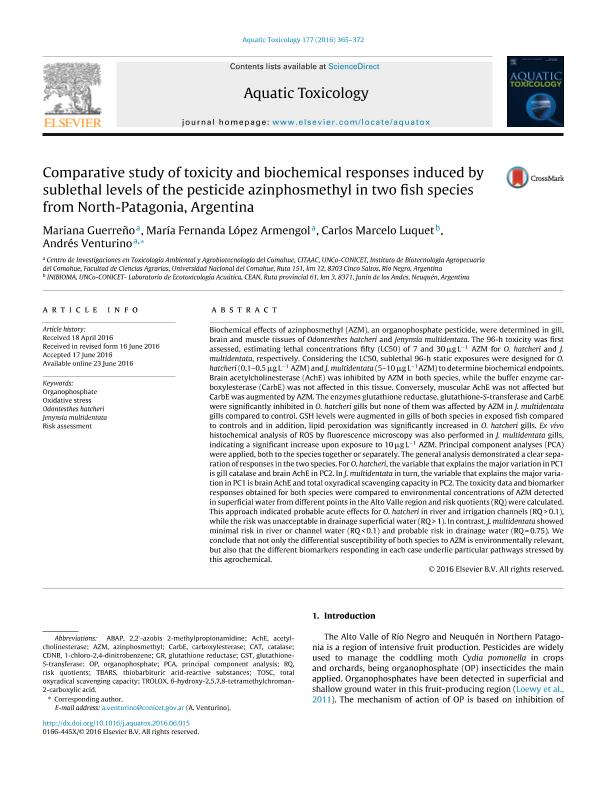Mostrar el registro sencillo del ítem
dc.contributor.author
Guerreño, Mariana

dc.contributor.author
Lopez Armengol, Maria Fernanda

dc.contributor.author
Luquet, Carlos Marcelo

dc.contributor.author
Venturino, Andres

dc.date.available
2019-02-06T20:15:35Z
dc.date.issued
2016-08
dc.identifier.citation
Guerreño, Mariana; Lopez Armengol, Maria Fernanda; Luquet, Carlos Marcelo; Venturino, Andres; Comparative study of toxicity and biochemical responses induced by sublethal levels of the pesticide azinphosmethyl in two fish species from North-Patagonia, Argentina; Elsevier Science; Aquatic Toxicology; 177; 8-2016; 365-372
dc.identifier.issn
0166-445X
dc.identifier.uri
http://hdl.handle.net/11336/69590
dc.description.abstract
Biochemical effects of azinphosmethyl (AZM), an organophosphate pesticide, were determined in gill, brain and muscle tissues of Odontesthes hatcheri and Jenynsia multidentata. The 96-h toxicity was first assessed, estimating lethal concentrations fifty (LC50) of 7 and 30 μg L−1 AZM for O. hatcheri and J. multidentata, respectively. Considering the LC50, sublethal 96-h static exposures were designed for O. hatcheri (0.1–0.5 μg L−1 AZM) and J. multidentata (5–10 μg L−1AZM) to determine biochemical endpoints. Brain acetylcholinesterase (AchE) was inhibited by AZM in both species, while the buffer enzyme carboxylesterase (CarbE) was not affected in this tissue. Conversely, muscular AchE was not affected but CarbE was augmented by AZM. The enzymes glutathione reductase, glutathione-S-transferase and CarbE were significantly inhibited in O. hatcheri gills but none of them was affected by AZM in J. multidentata gills compared to control. GSH levels were augmented in gills of both species in exposed fish compared to controls and in addition, lipid peroxidation was significantly increased in O. hatcheri gills. Ex vivo histochemical analysis of ROS by fluorescence microscopy was also performed in J. multidentata gills, indicating a significant increase upon exposure to 10 μg L−1 AZM. Principal component analyses (PCA) were applied, both to the species together or separately. The general analysis demonstrated a clear separation of responses in the two species. For O. hatcheri, the variable that explains the major variation in PC1 is gill catalase and brain AchE in PC2. In J. multidentata in turn, the variable that explains the major variation in PC1 is brain AchE and total oxyradical scavenging capacity in PC2. The toxicity data and biomarker responses obtained for both species were compared to environmental concentrations of AZM detected in superficial water from different points in the Alto Valle region and risk quotients (RQ) were calculated. This approach indicated probable acute effects for O. hatcheri in river and irrigation channels (RQ > 0.1), while the risk was unacceptable in drainage superficial water (RQ > 1). In contrast, J. multidentata showed minimal risk in river or channel water (RQ < 0.1) and probable risk in drainage water (RQ = 0.75). We conclude that not only the differential susceptibility of both species to AZM is environmentally relevant, but also that the different biomarkers responding in each case underlie particular pathways stressed by this agrochemical.
dc.format
application/pdf
dc.language.iso
eng
dc.publisher
Elsevier Science

dc.rights
info:eu-repo/semantics/openAccess
dc.rights.uri
https://creativecommons.org/licenses/by-nc-sa/2.5/ar/
dc.subject
Jenynsia Multidentata
dc.subject
Odontesthes Hatcheri
dc.subject
Organophosphate
dc.subject
Oxidative Stress
dc.subject
Risk Assessment
dc.subject.classification
Otras Ciencias Biológicas

dc.subject.classification
Ciencias Biológicas

dc.subject.classification
CIENCIAS NATURALES Y EXACTAS

dc.title
Comparative study of toxicity and biochemical responses induced by sublethal levels of the pesticide azinphosmethyl in two fish species from North-Patagonia, Argentina
dc.type
info:eu-repo/semantics/article
dc.type
info:ar-repo/semantics/artículo
dc.type
info:eu-repo/semantics/publishedVersion
dc.date.updated
2019-02-05T19:53:32Z
dc.journal.volume
177
dc.journal.pagination
365-372
dc.journal.pais
Países Bajos

dc.journal.ciudad
Amsterdam
dc.description.fil
Fil: Guerreño, Mariana. Consejo Nacional de Investigaciones Científicas y Técnicas. Centro Científico Tecnológico Conicet - Patagonia Norte. Centro de Investigaciones En Toxicología Ambiental y Agrobiotecnología del Comahue. Universidad Nacional del Comahue. Facultad de Cs.agrarias. Centro de Investigaciones En Toxicología Ambiental y Agrobiotecnología del Comahue; Argentina
dc.description.fil
Fil: Lopez Armengol, Maria Fernanda. Consejo Nacional de Investigaciones Científicas y Técnicas. Centro Científico Tecnológico Conicet - Patagonia Norte. Centro de Investigaciones En Toxicología Ambiental y Agrobiotecnología del Comahue. Universidad Nacional del Comahue. Facultad de Cs.agrarias. Centro de Investigaciones En Toxicología Ambiental y Agrobiotecnología del Comahue; Argentina
dc.description.fil
Fil: Luquet, Carlos Marcelo. Consejo Nacional de Investigaciones Científicas y Técnicas. Centro Científico Tecnológico Conicet - Patagonia Norte. Instituto de Investigaciones en Biodiversidad y Medioambiente. Universidad Nacional del Comahue. Centro Regional Universidad Bariloche. Instituto de Investigaciones en Biodiversidad y Medioambiente; Argentina
dc.description.fil
Fil: Venturino, Andres. Consejo Nacional de Investigaciones Científicas y Técnicas. Centro Científico Tecnológico Conicet - Patagonia Norte. Centro de Investigaciones En Toxicología Ambiental y Agrobiotecnología del Comahue. Universidad Nacional del Comahue. Facultad de Cs.agrarias. Centro de Investigaciones En Toxicología Ambiental y Agrobiotecnología del Comahue; Argentina
dc.journal.title
Aquatic Toxicology

dc.relation.alternativeid
info:eu-repo/semantics/altIdentifier/doi/https://dx.doi.org/10.1016/j.aquatox.2016.06.015
dc.relation.alternativeid
info:eu-repo/semantics/altIdentifier/url/https://linkinghub.elsevier.com/retrieve/pii/S0166445X16301783
Archivos asociados
